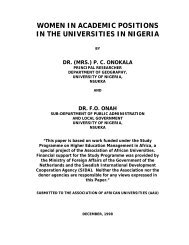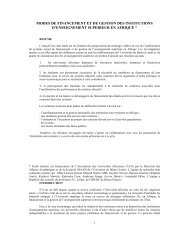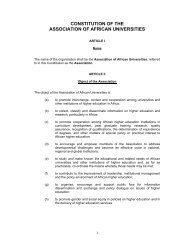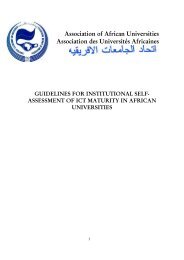undergraduates' attitudes and the study of mathematics at the ...
undergraduates' attitudes and the study of mathematics at the ...
undergraduates' attitudes and the study of mathematics at the ...
- No tags were found...
You also want an ePaper? Increase the reach of your titles
YUMPU automatically turns print PDFs into web optimized ePapers that Google loves.
INTRODUCTION<br />
Studies on gender disparities have been done in both developed <strong>and</strong> developing countries. In<br />
<strong>the</strong>se countries women in institutions <strong>of</strong> higher learning tend to concetr<strong>at</strong>e in certain fields <strong>of</strong><br />
<strong>study</strong> such as humanities, home economics <strong>and</strong> arts, though more women have now enrolled in<br />
o<strong>the</strong>r fields like business <strong>and</strong> public administr<strong>at</strong>ion. The enrolment in <strong>the</strong> fields such as m<strong>at</strong>hs<br />
<strong>and</strong> science rel<strong>at</strong>ed fields is however still limited. Low enrollment in m<strong>at</strong>hs <strong>and</strong> science fields<br />
can be said to result from a number <strong>of</strong> factors affecting women especially <strong>at</strong> different levels <strong>of</strong><br />
schooling. For example traditional <strong>and</strong> cultural expect<strong>at</strong>ions from different societies in <strong>the</strong><br />
developing world in particular, seem to have an influence on subject choice <strong>and</strong> selection<br />
especially <strong>at</strong> secondary school level.<br />
In developed countries,where many studies on gender differences in m<strong>at</strong>hs have been done, some<br />
different views have emerged whe<strong>the</strong>r <strong>the</strong> differences were declining in those countries or not.<br />
Also some studies in both developed <strong>and</strong> developing countries have indic<strong>at</strong>ed th<strong>at</strong> gender<br />
differences in m<strong>at</strong>hs performance existed in upper grades <strong>and</strong> th<strong>at</strong> <strong>the</strong>y were not significant in<br />
lower grades. The premise put forward is th<strong>at</strong> gender differences could increase as students go to<br />
higher levels <strong>of</strong> schooling. This article reviews such a trend with d<strong>at</strong>a involving performance,<br />
<strong><strong>at</strong>titudes</strong>, enrolment <strong>and</strong> dropout in <strong>the</strong> subject<br />
Gender studies in Sub-Saharan Africa<br />
Gender disparities in educ<strong>at</strong>ion in developing countries can be said to be characterised by some<br />
influences from cultural <strong>and</strong> traditional practices. In Sub-Saharan Africa, educ<strong>at</strong>ion has been<br />
influenced by for example indigenous cultures, religion <strong>and</strong> educ<strong>at</strong>ion provided in <strong>the</strong> western<br />
3
















